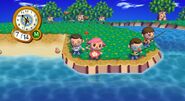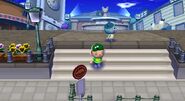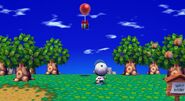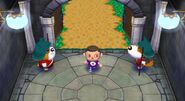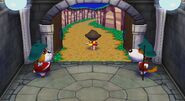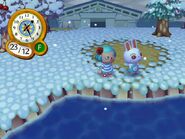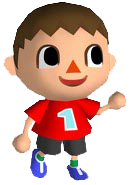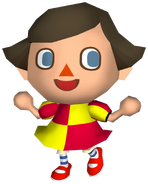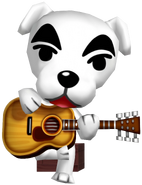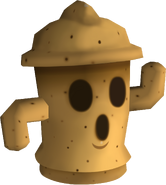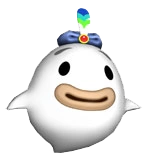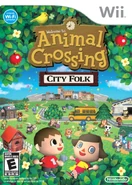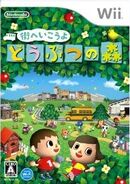Animal Crossing: City Folk, known in Japan as Animal Forest: Let's Go To Town (街へいこうよ どうぶつの森[3] Machi e Ikō yo Dōbutsu No Mori?), in South Korea under a similar title as Animal Forest: Let's Visit the Town (타운으로 놀러가요 동물의 숲, Tauneuro Nolleogayo Dongmul-ui Sup) and Animal Crossing: Let's Go to the City in Europe, is a video game title in the Animal Crossing series. It is a life simulation game where the player lives with animals, same as the other games (ex. spin-offs). It was released in North America, Japan, Europe, and Australia on November 16, 2008, November 20, 2008, December 5, 2008, and December 4, 2008, respectively.[1] The title boasts a variety of changes and additions to the Animal Crossing formula, including the ability to travel to the City.[1]
New Features
City Folk takes advantage of the WiiConnect24 functionality of the Wii console.[4] It also uses a new feature called Wii Speak, which allows players to talk to each other when visiting each other's towns.
There are now 64 insects and fish which is an increase of 8 since Wild World, which had 56 insects and fish.
The City & New Attractions
This incarnation of the Animal Crossing series features a newly accessible location called the City. The City houses most of the characters that, in previous games, were considered special visitors. These include Gracie the Giraffe and Redd the Fox, among other characters such as Dr. Shrunk and Lyle. This area of the game is available via Kapp'n's bus, and is open all hours of the day. Most of the shops close at 9 PM daily, with the exception of Redd's Store and The Resetti Surveillance Center.
The City Plaza also features new characters Phineas the sea lion and Kicks the skunk. Lyle now works in the Happy Room Academy and Shrunk now works at the Marquee next door. The player can now find Gracie in her store, GracieGrace, who is managed by the new character Labelle.
The game also features more Holidays, such as; Halloween, Harvest Festival, Christmas, Festivale and many others.
Moving
When moving in, the player has two options; to start fresh or to move in as their DS character. Moving in as their character will only keep the Wild World character's catalog and appearance. However, not all items transfer from a Wild World save, such as the Royal Crown. No items, Bells or house size will be ported with the character. If the player has an illegal game storage device, such as an R4 card or a TTDS, the moving function will not work.
Wi-Fi
This version of the Animal Crossing series features Wi-Fi capabilities, which was earlier implemented in the previous game, Wild World. This feature gives the player access to other towns, enables them to communicate with friends' towns with letters, and also subjects them to special furniture items sent from time to time from Nintendo, such as Nintendogs statues and the Red Pikmin Hat, which reference some of the company's best-selling franchises. It also allows players to experience another feature, which in-game is the Mysterious Cat. This enables a visit from Blanca, a character who travels via Wi-Fi into towns, which promotes connectivity between players locally and globally. It has no compatibility with its 3DS counterpart. On May 20th, 2014, Nintendo Wi-Fi Connection on the Nintendo DS and Nintendo Wii was discontinued. This terminated the Wi-Fi capability of City Folk.
Development and unveiling
The conception of City Folk began during the production of Wild World and was confirmed that an Animal Crossing title for the Wii, then codenamed Revolution, was in development. Katsuya Eguchi, the producer of both titles, suggested that the two titles may be able to link up to one another at e3 2005.[5] In 2006, Eguchi confirmed that City Folk was still just a concept and very little work had been completed. His time was being consumed by research and development of the Wii console.[6] The Animal Crossing team explored ways to involve the Wii Remote. They planned to allow players to use tools, such as the axe, shovel, and fishing rod. They also explored the use of WiiConnect24 in the hopes that a player could visit a friend's town even when they were not playing. The friend could then leave letters or gifts. Additionally, they planned to use Wi-Fi Connection to allow simultaneous play. At this point in time, however, the title was still not playable.[7]
In early 2007, Nintendo of Japan unveiled its video game lineup for the coming year. It included "Doubutsu no Mori" ("Animal Forest").[8] Having finished the Mii Channel for Wii, Wild World director Hisashi Nogami joined the Animal Crossing team.[9] Later that year, Edge Magazine reported that a trusted source confirmed that City Folk would be a massively multiplayer online game. The publication declined to name the source.[10] Nintendo failed to release the title in 2007. Online publication IGN predicted that the title would arrive in 2008.[11]
At E3 2008, Reggie Fils-Aime unveiled the title in playable form under the name City Folk. It was released in November 2008.[12]
People who owns shops in the city
Harriet the Poodle (Shampoodle)
Harriet was first introduced in the previous Animal Crossing game which was called Wild World. She appeared in Nookington's by the stairs and she was moved to the right hand side of the city. Her store is Shampoodle.
Kicks
Kicks was a new character in City Folk, he owned a business of shining shoes. You can see him in between Lloyd's store and Shampoodle.
Redd's shop
Redd's shop is a corner shop in the city. It has a metal door and it's found near the west side of the city, next to the Marque. The shop sells art such as paintings and statues. These can be later donated to the Museum but you have to make sure they aren't fake.
Gallery
Publisher screenshots
Artwork (Characters)
Artwork (Villagers)
Boxart
Release and reception
Initial editorial previews of the title from IGN and GameSpy indicate that, as with the title's predecessor, Wild World, Nintendo has made very few changes to the title and that some Animal Crossing players, who have played all of the past Animal Crossing games, might not find as much in City Folk, than other Animal Crossing games, although, the game is still fun and might appeal to newcomers. IGN gave City Folk a 7.5/10 rating. E3 2008: Animal Crossing: City Folk Hands-on. GameSpot gave a positive preview of the title, noting the charm of the game, but gave the game a 7.5/10 rating.[13] The game's MSRP was $49.99 on release, but was later dropped to $19.99. Some copies of City Folk include Nintendo's Wii Speak. These copies of City Folk were sold for $69.99, but was later dropped to $34.99-$49.99.
References
- ↑ 1.0 1.1 1.2 1.3 1.4 1.5 1.6 Animal Crossing: City Folk. Nintendo.com. Accessed 7-24-08.
- ↑ Animal Crossing: City Folk. Gamespot. Accessed 7-25-08.
- ↑ https://www.nintendo.co.jp/wii/ruuj/index.html
- ↑ http://wii.ign.com/articles/709/709218p1.html
- ↑ Casamassina, Matt (5-19-2005). E3 2005: Animal Crossing Revolution. IGN Wii. Accessed on 7-22-2008.
- ↑ Harris, Craig (3-24-2006). GDC 06: Chat with Eguchi. IGN Wii. Accessed 7-22-08.
- ↑ Casamassina, Matt (5-18-2006). Interview: Wii Sports. IGN Wii. Accessed 7-22-08.
- ↑ Casamassina, Matt (2-22-07). Nintendo Lists Major Wii Games for 2007. IGN Wii. Accessed 7-22-08.
- ↑ Casamassina, Matt (7-12-07). E3 2007: Animal Crossing Update. IGN Wii. Accessed 7-22-08.
- ↑ Casamassina, Matt (10-24-07). Rumor: MMO Animal Crossing. IGN Wii. Accessed 7-22-08.
- ↑ Bozon, Mark and Casamassina, Matt (1-18-08). IGN Preview 2008 p.9. IGN Wii. Accessed 7-22-08
- ↑ DeVries, Jack (7-15-08). E3 2008: Animal Crossing Coming to Wii. IGN Wii. Accessed 7-22-08.
- ↑ name="GameSpotpreview" Kevin VanOrd (7-15-08). E3 2008: City Folk Hands-On.
| Animal Crossing: City Folk | ||
|---|---|---|
 | ||
| See also | ||
| Games | ||
| Video games | |
|---|---|
| Main series | Dōbutsu no Mori (Dòngwù Sēnlín) · Dōbutsu no Mori + · Animal Crossing · Dōbutsu no Mori e+ · Wild World · City Folk · New Leaf (Welcome amiibo) · New Horizons |
| Spin-offs | |
| Other media | |
| Other series | |


